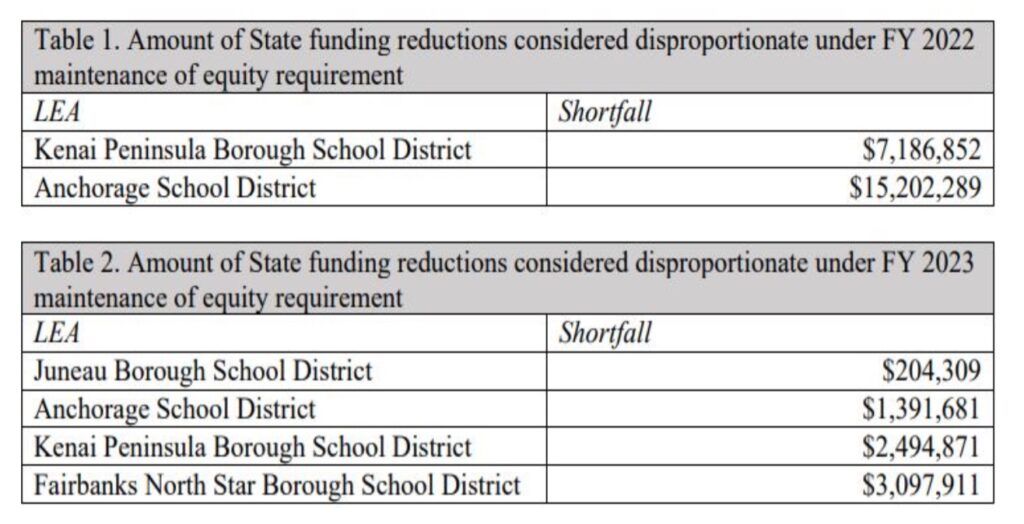
Biden Press Conference
The U.S. Department of Education is accusing the State of Alaska of mismanaging its Covid-19 relief funds by not allocating enough to our urban school districts.
Instantly, the leftist media jumped on the bandwagon to charge Commissioner Deena Bishop with misuse of these federal taxpayer dollars. The federal government wants the State to provide more and more funding to the urban school districts, and less to the rural districts.
This is micromanagement at its worst.
The Alaska Department of Education and Early Development was told by the federal agency that Alaska was not providing “equity” in its distribution of Covid relief funds, the American Rescue Plan. The Feds referred to this as “maintenance of equity.”
The American Rescue Plan for the first time ever required a “Maintenance of Equity” clause that said states could not reduce their per-pupil funding to low-income and high-needs school districts.
It seems as if “equity” has permeated the entire federal government, and it wants to now dictate how Alaska spends its money.
But the federal government approved all the states’ plans on distribution of these same funds.
Per the DEED’s web page, “The ARP Act provides funding to help meet a wide range of needs arising from the COVID-19 pandemic, including reopening schools safely, sustaining their safe operation, and addressing students’ social, emotional, mental health, and academic needs resulting from the pandemic”.
Alaska responded to this concern on March 8, 2024, but the federal government was not satisfied with the answer. It stated that, “the State remains non-compliant for high-need and highest-poverty local educational agencies…”. (A local education agency is a local school district).
In its March 22, 2024 letter to the USDOE, Alaska said, “State funding was not cut during fiscal years 2019-2023. Instead, Alaska continued to apply and fund its base student allocation in accordance with existing state law…”.
In its response, DEED also stated that to solve the federal goernment’s concerns, it could ask for a supplemental appropriation from the legislature.
But the federal government was still not satisfied and wanted even to interfere with the legislative process of additional funding. It demanded that Alaska ask for a “supplemental appropriation to resolve the maintenance of equity compliance issues.”
And it demanded the governor ask for this appropriation now.
Then the DOE designated the State as a “high-risk grantee” for its Covid grants.
The DOE says that the State did not maintain providing the same level of funding equity during FY 2022 for one high need school district and one highest poverty school district.
Here are the school districts and the so-called fund shortages from the DOE letter:

Note that the MatSu School District, one of the five largest, is not mentioned in the federal listing. That may be because that district kept its schools open during the pandemic and gained many students.
This $29 million does not seem very significant when it comes to a statewide K-12 budget exceeding $2.7 billion.
Here are the American Rescue Plan funds that were doled out to the above school districts: Anchorage School District received more than $116.4 million; Kenai School District received more than $20.1 million; Juneau got more than $5.3 million; and the Fairbanks School District received more than $22.8 million.
The entire State of Alaska received $265,383,276 in ARP funds. Of these,$68.9 million — some 21% have still not been spent.
The DEED Commissioner Deena Bishop responded strongly to the DOE: “This is an incredibly surprising conclusion considering we funded our schools as we always have according to the equitable distribution formula as established in Alaska Statutes and also distributed any COVID funds based on the Title 1 Part A formula per federal guidance.”
Bishop continued, “Alaska has been applauded by several outside entities for the equity of our school funding formulas, including Rutgers University. To now come back and suggest that we need to give additional funding to some of our largest school districts, which takes the equitable distribution and upends it at the expense of our smaller, rural school districts, makes no rational sense. In short, the way ED is demanding Alaska distribute funds to comply with maintenance of equity requirements is inequitable for Alaska’s rural schools,” she said.
Does the federal government want to challenge Alaska’s education funding formula and dictate that as well?
This is just another indication of the control the federal government wants over a state’s K12 education.
In its final attack on Alaska, the Department of Education singles out the State saying, “Alaska is the only State that has not met, or presented a sufficient plan for meeting, these requirements.”
That would seem to be highly doubtful due to the many school districts’ budgets.
This adds nothing to the conversation and seems to attack our governor and the DEED.
What’s next? Will the federal government use its 4,000-mile screwdriver to take away school lunches from low-income kids?



![Body temperature check, prevent virus Concepts in preventing contagious diseases. Corona virus [Covid-19] . social distancing concept.Operator Check Fever by Digital Thermometer Visitor](https://ak4pf.org/wp-content/uploads/2025/03/business-woman-covid-19-2024-10-18-05-28-48-utc-150x150.jpg)





![Body temperature check, prevent virus Concepts in preventing contagious diseases. Corona virus [Covid-19] . social distancing concept.Operator Check Fever by Digital Thermometer Visitor](https://ak4pf.org/wp-content/uploads/2025/03/business-woman-covid-19-2024-10-18-05-28-48-utc-300x196.jpg)


